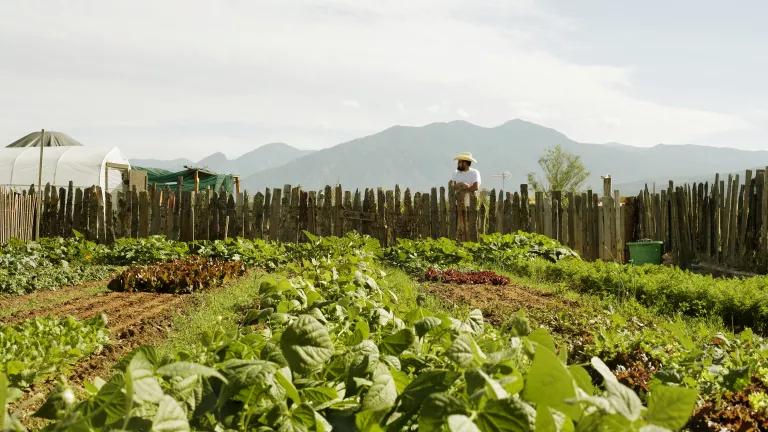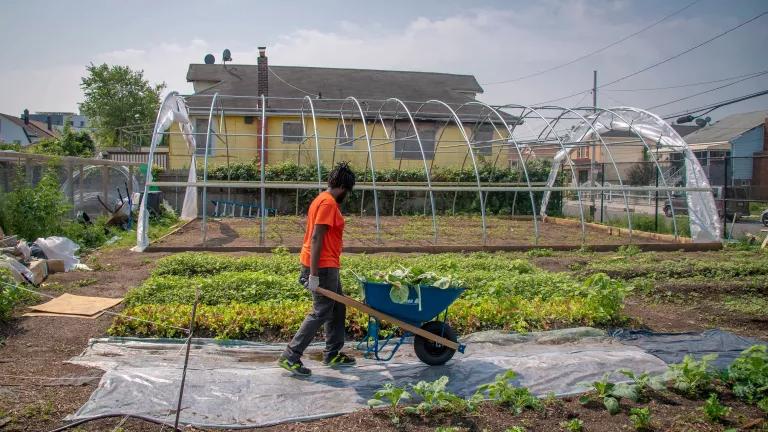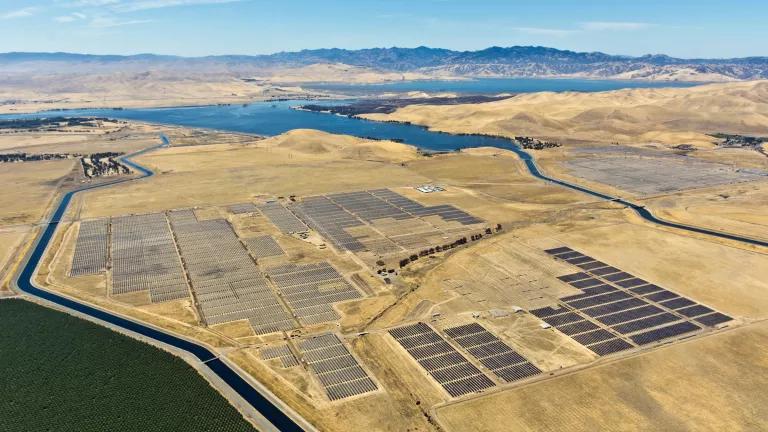Biden to Engage Farmers & Build Climate Resilience
By prioritizing natural climate solutions and agricultural resilience, the Biden-Harris climate plan promises to guide U.S. food and farm policy into the 21st century.

Farmer on an organic farm in Taos, New Mexico
Climate-friendly farming practices can supercharge efforts to combat climate change. Healthy soil helps farms survive droughts, floods and other extreme weather AND pulls carbon out of the atmosphere. Better farm practices also mean healthier food for everyone, less air and water pollution, and a much-needed boost to rural economies. By prioritizing natural climate solutions and agricultural resilience, the Biden-Harris climate plan promises to guide U.S. food and farm policy into the 21st century.
An opportunity to transform U.S. agriculture
President-elect Biden has promised to stand with farmers as they struggle in a changing climate and partner with them “to make American agriculture the first in the world to achieve net-zero emissions.” The Biden-Harris climate plan recognizes that to get to net zero and increase resilience, the U.S. must ramp up sustainable agriculture financing and research and reward on-farm emissions reductions. Specifically, the plan promises to “invest in climate-friendly farming such as conservation programs for cover crops and other practices aimed at restoring the soil and building soil carbon.”
Climate-friendly farming—including regenerative and organic farming—is a key part of the climate solution, and it offers a wide range of environmental co-benefits, health protections, and economic opportunities. Regenerative and organic farmers work with nature to build healthy soil and ecosystems, instead of relying on fossil-fuel based pesticides and fertilizers to grow crops or excessive antibiotics to raise livestock.
Their farming practices, including cover cropping, crop rotation, rotational grazing, compost and natural fertilizers, and safer pest management, protect waterways, biodiversity, and—critically—farmworkers, who are vulnerable to health risks from pesticide and antibiotic exposure, as well as the extreme heat and wildfires that are increasingly common in a changing climate.
Despite all these benefits, only a small percentage of U.S. farms have adopted regenerative organic practices, in part because U.S. farm policy has not prioritized the health of people or the future of the planet. Bringing the Biden-Harris climate plan to life will require a tidal shift.
Agricultural policy shapes our natural world and the food economy—for better or worse
We spend more than $20 billion a year on subsidies for farm businesses (and nearly double that in 2020, thanks to the Trump tariffs and COVID relief), yet those subsidies are not deployed in a way that engages farmers or eaters in the fight against climate change; in fact, U.S. agriculture is more vulnerable to climate change thanks to our current subsidy system. By shifting some public investment in agriculture to climate-friendly farming, we could transform the sector from a net carbon emitter to a carbon store and do a better job of nourishing our communities.
Also, by directing technical assistance and financial resources to Black, Latinx, and Indigenous farmers and other disadvantaged farmers, we can begin to address historic injustices in our food system.
Climate progress requires diversified crops and diversified leadership
To earn the trust of the farmers he plans to stand with, and to help them drive the U.S.’s transition to climate-friendly farming, the President-elect should immediately deliver what the Trump administration has not: Meaningful support for farmers and workers who steward our land, resources, and health, especially Black, Indigenous, Latinx, and other producers of color.
Biden should launch a new, comprehensive program to help farmers transition to climate-friendly organic and regenerative practices. The transition program will support farmers and workers who prioritize storing carbon in the soil and reducing reliance on fossil fuel-based fertilizers and pesticides, including farmers engaged in the three-year transition to organic agriculture. The program should include technical assistance, grants, research, farmer-to-farmer mentorship, worker training resources, and specialized staff to ensure that farmers and workers can make the most of these supports. The program should link with expanded civilian conservation corps programs that include beneficial projects on private lands, such as restoring riparian areas, planting prairie strips, and building compost infrastructure.
In addition, because communities of color and low-income communities have faced disproportionate harm from climate change, environmental contamination, and discriminatory agricultural policies, socially disadvantaged farmers and ranchers (i.e. producers of color) should receive at least 40% of the program resources.
Simultaneously, Biden should use agricultural policy and our public investments in agriculture to promote better climate and health outcomes. He should issue an Executive Order that (1) increases investments in healthy soil and sets reduction targets for use of toxic fossil fuel-based pesticides and fertilizers, and (2) limits the federal government’s climate footprint through food waste reduction and climate-friendly procurement strategies.
He should also incorporate incentives for practices that enhance resilience and sequester carbon directly into the largest federal farm subsidy: crop insurance. Several states have already adopted “good driver discount” incentives for farmers who use cover crops, a practice which has been demonstrated to reduce the risk of crop loss and improve soil health. Biden should support expanding these programs across the entire Federal Crop Insurance Program.
Finally, as the administration moves to implement the Climate Plan, including the promise to “[invest] in diverse farmers to make our agriculture sector stronger and more resilient,” they should make room for more diversity in agricultural leadership. Black, Indigenous, Latinx, and other farmers and agricultural workers of color draw on generations before them who nourished communities in partnership with nature. Holistic and effective transformation of the food and agriculture sector must center their wisdom and advance racial equity. Biden should immediately rescind the Trump Executive Order prohibiting anti-racism training at agencies and issue one that proactively serves producers of color.
In his first 100 days, all staff at USDA, DOI, HHS, EPA, and other relevant agencies must become familiar with the federal government’s history of racial discrimination and the steps that they will now take to foster racial equity in agriculture. In addition, the administration should commit a portion of funding in every USDA program to meet the needs of producers of color.
Our food system is an ecosystem, and our policies should make it healthy, just, and resilient
We urgently need a comprehensive federal food and agriculture agenda that aligns climate goals with agricultural incentives, nutrition needs, and worker safety. Ultimately, the food system must protect the environment; provide good jobs and economic stability for farmers and all food workers; and ensure that all communities have access to affordable, healthy, and culturally appropriate food.
This is a long-term transition that can begin—but won‘t end—with the Biden-Harris Climate Plan.




